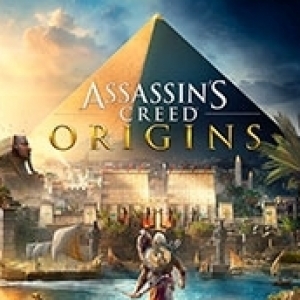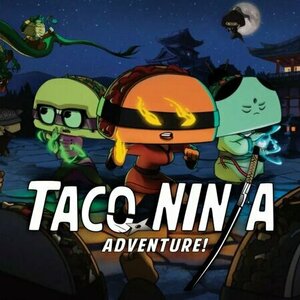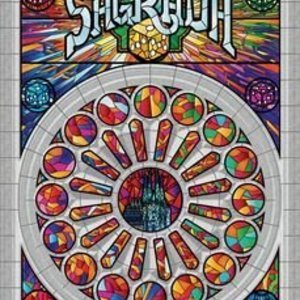Purple Phoenix Games (2266 KP) rated Lonely Undead in Tabletop Games
May 24, 2021
Lonely Undead is a hand management, grid movement, zombie adventure game for one to four players with a super crazy theme. In it, players are Zs looking to make some friends in the neighborhood, but most unturnt neighbors are keeping their distance. So what’s a Z to do? Go bite and infect people so they can be friends forever, of course!
DISCLAIMER: We were provided a prototype copy of this game for the purposes of this review. These are preview copy components, and I do not know for sure if the final components will be any different from these shown. Also, it is not my intention to detail every rule in the game, as there are just too many. This preview will be highlighting the co-op mode with two players. You are invited to download the rulebook, back the game through the Kickstarter campaign, or through any retailers stocking it after fulfillment. -T
To setup, lay out the board somewhere on the table (thankfully the rules do not specify where, so go ahead and be a bit off-center this time). Zs (the players) all start in “Dead Center” of the board. The rulebook indicated how to construct the Living deck, and each deck of different types of cards should be shuffled and put in their place either on the board or just off it. For sake of ease, use the rulebook’s suggested placement of Living (so, NOT the Zs) tokens. Each player receives or chooses a Z to embody, receives two Aid cards, four Limbs, and the game is setup and ready to begin!
Lonely Undead is played over a series of rounds, with each round consisting of two phases: Z Phase and Town Phase. During the Z Phase, the active player will have four actions they may take from the following choices: Movement, Draw an Aid Card, Equip a Card, Sound Check, Attack, and Bite. Each Z has their own unique card with their special actions and other stats. A Z may move up to their Movement amount,including diagonally, for one action.
Aid Cards are very helpful to Zs, and for an action a Z may Draw an Aid Card to their hand. Aid Cards could be stat modifiers, or other special actions available to be used. Some Aid Cards are free to use, but if that text is not on the card, a Z will need to spend an action to Equip a Card to their Z.
When the Z is adjacent to a Living token, they must Sound Check it in order to identify the kind of Living they are stalking. To do this a Z rolls the Chance Die and applies any modifier rolled to their base stat on their card for hearing. This is compared against the Living card that is drawn to see if the Living notices the hunting Z. If the Z is successful in this Sound Check (winning all ties), then the Z may continue with their turn. If the Z fails the check, however, the Z will suffer the consequence detailed on the Living’s card. Once the Living has been identified through a Sound Check (successfully or not), the Z may next Attack the Living by rolling the Chance Die again and applying the modifier to the base attack stat. If successful, the Z flips the Living token over to reveal the injured side, notating that the Living does not need to be Sound Checked again, and is ripe for the bitening. If the Z fails an Attack, though, they will suffer any consequences detailed on the Living’s card. When a Living is injured, they are vulnerable to a Z’s Bite. The Z will roll the special Bite die in an attempt to meet their Bite range on the Z’s character card. A successful Bite means the Z collects a friend and moves that much closer to victory! A failed Bite means the Z must place a color-matched Bite token on the Living standee to signify they cannot be Bitten by that same Z again.
Once a Z has taken their turn, they will draw a Reaction card from its pile. Reactions could be either beneficial to the Z, or could be very very bad news. Some Reaction cards bring Dogs into the game, and these Dogs chase and bite the Zs that drew them. Every Dog bite causes damage to the Z and after all their Limbs are gone, they are perma-dead and out of the game. Other Reactions could cause a Car to zoom down the street, mowing over anything in their path (Zs, Dogs, Living, etc).
In the cooperative mode, players work together to gain 15 friends before 10 Living perish and are placed on the Death Toll tracker. Every two Living tokens on the Death Toll tracker forces the players to draw and enact a Death Toll card. Once the win condition is met the players win!
Components. Again, this is a prototype copy of the game, so components will probably be a bit different in the final version. That said, I do have some opinions here. Firstly, there are a LOT of components included in this game. I am sure that they will all receive some kind of improvement in the final copy, so I will not comment on quality. I was able to play the prototype several times and had no problems with the components doing their job. I do have a comment on the art style. It’s just not my favorite. Now, this is obviously personal opinion, and it certainly does does not turn me off from the game at all. I just need to get it out to the aether that a different art style or genre may fit the game a bit better.
That all said, I THOROUGHLY enjoyed all my plays of Lonely Undead. Once the turns start cookin, you just don’t want to stop playing. Yes, there are random events or spawns that cause some chaos for our heroes, chief of which are the Dogs. Those little buggers will chase you all over town to get that juicy bite off and take one of your Limbs. I hate to say this, but there were many times I hoped to draw a Car card so that it could run over the Dogs (now, in real life I love dogs, but they are perfectly annoying in Lonely Undead). The variety of Z special powers lead to interesting combinations when playing co-op or competitively. However, I honestly prefer the co-op mode here.
In co-op, players are (obviously) working together to Bite and infect as many Living as they possibly can. This makes for some strategic placement between players, as well as combat tactics when Livings are clustered together in a building. Perhaps one Z is better at handling Officers, while another can more easily prey upon Livings from outside areas. Being able to set strategies and tactics by working together has made for some very excellent gaming experiences.
I’m going to be honest, as I always try to do. When I opened up Lonely Undead and saw the art style, I was a bit turned off. But, as I learned the game and played through it several times, I grew to really enjoy the game. I think it’s a great example of taking a tired theme and breathing a bit of new life into it. Yes, zombies are trying to eat people, but typically in zombie games the players are working AGAINST the zombies, not AS the zombies. I think this is a very clever spin. I have certainly and purposefully left out a few rules as surprises for gamers who decide to back this one, and I would recommend that you at least check out the Kickstarter campaign. This may not be for everyone, and even if the art doesn’t change, it is definitely for me. Kudos to Shelby Matussak and Dead Lemon Games for a fine first entry into the gaming world.
CHOMP!
Onearmedcookie (6 KP) rated the PlayStation 4 version of Assassin's Creed: Origins in Video Games
Feb 10, 2018
Yet since the second game appeared, and introduced us to the charming Ezio, I have been hooked. The latest installment – entitled Origins has seen Ubisoft go back to the drawing board redesigning some of the games mechanics. Hoping to breathe new life into the series, whilst spinning another tale in history. I have to confess for the most part it has proved to be rather successful.
I have rather enjoyed this series, playing through all of the different historical places. The last in the series though, Syndicate was superb. Instantly my favourite so far so for me Origins – had a lot to live up to! I was worried initially when, Ubisoft had decided to delay the next instalment for a year whilst they looked at redesigning elements that for me had previously worked fine.
With this in mind, I loaded the game into my trusty PS4 and began my journey! Origins takes place in ancient Egypt just as Cleopatra is fighting for the throne. The game centres around a Medjay named Bayek and his wife Aya who find themselves thrust into the fight for Egypt between Cleopatra and the new Pharaoh – her brother - Ptolemy XIII. This is the birthplace of the assasins guild and the beginning of their fight against the knights of the templar!
The story is captivating, well thought out and the characters soon jump from the screen making you want to push forward to see what happens to them. In fact the characters are some of the best in the series, they have been developed well with real character development making them seem even more real. You can’t help but feel immersed in this new word as you discover more of Egypt. I also want to point out how well the characters are voiced, the voice acting in Origins is top notch. Fuelled with emotion and true grit, this only opens them up more. Making the game feel deeper than any before in the series. This is tory telling at its best.
I mentioned that Ubisoft went back to the drawing board on this one, changing some of the formula that we’ve all become used to. This is a bigger world to explore than any before it, Egypt is epic in scale and lovingly recreated. The world is brimming with life and it certainly feels like a more open world adventure than the previous instalments in the series. You can backtrack revisiting other areas or totally bypass them – the choice is yours.
There also seems to be a bigger range of side quests, helping you level up the character – unlocking handy upgrades as you go. Crafting is even present albeit in a simpler format than in most RPG’s. Similar to the Farcry series you can now hunt the wildlife in the area to help craft better equipment.
One of the biggest changes for me though, was the Eagle vision! Gone is the yellow vision highlighting heat signatures in red, with targets in gold allowing you to see through walls. Now you get to fly a real Eagle above you in the sky – tracking enemies and other areas of interest. It adds a whole new dimension to the game, casing an enemies camp from the sky – tracking their movements from up above really adds to the feel of the game. As you level up you can also have the Eagle attack and distract enemies allowing you to sneak past areas unseen. I love this idea and could quite happily fly Sensu around the environment for hours on end.
Combat has also been overhauled. Alas, for me this is probably the weakest part of the game. You can now block with your shield by pressing the L1 shoulder button. Heavy and medium attacks are found on the R1 & R2 buttons. For ranged attacks you press L2 to equip your bow! Sounds okay, but in practice I have found this new layout a trifle irritating. Imagine three guards are rushing you, you hit one and then go to block a blow with your shield – darn it you accidently hit L2 instead and suddenly you have your bow in your hand, getting cut up by two other guards! Frustrating isn’t the word. Especially when you get to some of the higher level guards with better AI.
Other than the combat though this is a solid game, with a very in depth strong story and well developed characters. If you got a little bored with the series, then this is the game to get you back in. It’s bold, with a beautifully crafted world to explore. Assassin’s Creed is back and it’s about time!
Purple Phoenix Games (2266 KP) rated Taco Ninja Adventure in Tabletop Games
Feb 15, 2021
Taco Ninja Adventure is a card battling game for two to six players where each player will control at least one Taco Ninja. It’s a taco head with a bipedal humanoid body. And they know ninjutsu. These ninjas duke it out on the battlefield to display the greatest technical skills and the Taco Ninja team that can deliver the final bite to the opponents will be the winner.
DISCLAIMER: We were provided a copy of this game for the purposes of this review. This is a retail copy of the game, so what you see in these photos is exactly what would be received in your box. I do not intend to cover every single rule included in the rulebook, but will describe the overall game flow and major rule set so that our readers may get a sense of how the game plays. For more in depth rules, you may purchase a copy online or from your FLGS. -T
To setup each team (in my case I played two player so we each controlled two Taco Ninjas) will choose their Taco Ninjas in alternating fashion and begin the game in the Battlefield (near each other on the table). The Item and Attack card decks are to be shuffled and the first three Attack card revealed to create a market row. Each player draws two Item cards to be kept secret from the opposing team and a life tracker with the cube on 30 HP. The death battle may now begin!
On a turn the player will decide whether they would like to stay on the Battlefield to fight or retreat to the Dojo to retool. If they remain on the Battlefield the active Taco Ninja will choose an opponent also on the Battlefield to target. Three Yahtzee-style dice rolls later the attacking Taco Ninja will either deliver damage to the opponent, heal themselves, or draw an Item card to be used on a later turn. Each of these results are compared against a reference card that shows successful attacks for 3 of a Kind, 4 of a Kind, Full House, and 5 of a Kind for maximum damage. Rolling two pairs yields an Item card and either 4 or 5 in a row yields healing to the active Taco Ninja.
Should the Taco Ninja wish to retreat to the Dojo they may instead draw either an Item card, one of the face-up Attack cards, or an Attack card blindly from the top of the deck. Item cards can be played on the owner’s turn or out of turn in some cases. Attack cards usually will add damage to successful attacks if its specific dice roll requirement is met.
Once a Taco Ninja is knocked out from sustaining too much damage they are sent to the Afterlife. While a Taco Ninja exists in the Afterlife they will still take turns rolling. They can roll certain results to heal their teammate still on Earth or even reincarnate if the correct result is rolled.
When one team has sent both of their Taco Ninjas to the Afterlife they are finished and the winning team may devour their remains. If these are actually cannibalistic anthropomorphic tacos.
Components. This game is mostly cards with a few cubes, five dice, and a cloth drawstring bag. The cards are all fine, the cubes of normal quality and brown and orange in color, and the dice are the small dice (maybe 12mm?). The art style throughout is obviously cartoony tacos, so it invokes a feeling of silliness that I appreciate. I do not really know what the bag is for other than to protect the cubes and dice in the box? In the rules it mentions a first-player marker, which I found none of in the box, so I used the bag as that marker. It’s a nice bag. No problems with the components from me.
I do have a slight grumble with the name of the game, however. This is a head-to-head card and dice-based deathmatch. Unfortunately the Taco Ninjas do not actually go out adventuring, just battling and dying. So I think a more apropos title could have been Taco Ninja Crunchfest or On Eating Taco Ninjas. That’s ridiculous and I am sorry for making you read this paragraph.
All in all the game is actually quite a good time. It is very light and simple to learn, but strategizing attacks and when to retreat to grab more Item and Attack cards is great. Yes, at the end of the day all turns are decided by dice rolls, so no amount of strategy should logically work fully, but it is still fun to just roll dice and demolish some tacos in the process. Please do not expect anything more than a nice little filler game here. A game night probably will not revolve around Taco Ninja Adventure, but perhaps several games using different characters or a round-robin tournament could be enjoyable.
That said, Purple Phoenix Games gives this one a delicious 8 / 12. It is highly portable, very light, appetizingly fun, and has a unique theme. If you are looking for a good solid filler game that is a bit different in style and theme than most, I would have you take a look at Taco Ninja Adventure. It might just be the cardboard antipasto you have been seeking.

Graham Bonnet: The Story Behind the Shades
Book
Graham Bonnet was born in Skegness in 1947 and had his first hit single with The Marbles in 1968,...

Notepad+ Pro
Productivity and Utilities
App
Fully optimized for iPad Pro and Apple Pencil! Notepad+ is pen and paper right on your iPad...

Candy Blast Mania
Games and Entertainment
App
Candy Blast Mania is a match 3 puzzle game where you can match and collect candies in this...

Football Director 2017
Games and Sports
App
Welcome to Football Director 2017, one of the best football soccer manager type games. As fast paced...
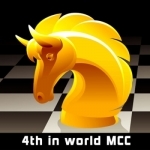
Chess Pro with Coach - Learn,Play & Online Friends
Games and Entertainment
App
Mastersoft Chess has one of the World's best Desktop PC chess engines crammed inside! It will...
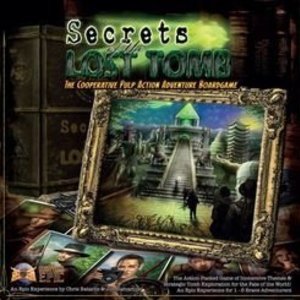
Secrets of the Lost Tomb
Tabletop Game
Secrets of the Lost Tomb is a cooperative game of thrilling action-adventure and discovery. Players...
Purple Phoenix Games (2266 KP) rated Sagrada in Tabletop Games
Jun 12, 2019
In Sagrada, you are an artist who has been tasked with creating a beautiful stained glass window. Working piece by piece, you build a masterpiece – the likes of which have never before been witnessed. Finding the perfect pieces can be tricky, but through careful use of your tools and with your artistic vision, you can create the best window in the town! The game is played over 10 rounds in which players draft dice and place them in their windows, following certain placement restrictions. A set number of tools are available for use, and can aid you in manipulating the dice to your benefit. Points are scored based on successful completion of private and public objectives, and the player with the highest score at the end of 10 drafting rounds is the winner!
My favorite part about playing Sagrada solo is that the game is essentially played the same way, regardless of player count. The only difference is how you win! In both group and solo play, each player will draft two dice every round. In group play, any leftover dice are discarded, while in solo play, the remaining two dice will be added towards the Target Score – the score you are trying to beat at the end of the game! To find the Target Score, you add all of the die values of your unused dice from each round. If, at the end of the 10 rounds, you have earned more points than the Target Score, you win! But if the Target Score is higher than your final score, you lose.
The game play differences are simple enough, but actually winning the game solo is a different story. I have played Sagrada solo quite a bit, and have won maybe 25% of the time. Depending on which window card and objectives are in play, and because of placement restrictions, I often have to sacrifice high-valued dice to the Target Score. And since there are no placement restrictions for the Target Score, and two dice are added to it each round, it is very easy for that score to sky-rocket. I either barely pull off a win, or I lose by a huge margin. Playing in a group is nicer in this regard because the other players have the same placement restrictions that I have – nobody is just getting points for free. Without the Target Score, there really is no way to play Sagrada solo, but it makes the game feel a little imbalanced to me.
Just because it is difficult to win solo does not mean that I do not like the game. It requires quite a bit of strategy, and that keeps me engaged for the entire game. There are dice placement restrictions based on color AND value, so there are two different ways in which you have to constantly be strategizing. You can’t just focus on either value or color – your strategy must always be changing based on which color dice are drawn and what values are subsequently rolled. Even with the amount of strategy required, Sagrada actually plays pretty quickly as a solo game, and I really like that. I like the challenge of this game, and often try to play until I can win. Since I can finish an entire solo game in probably 10-15 minutes, I am able to get multiple plays in a row!
Sagrada is a challenging game to play solo, but not in a way that feels futile. I don’t win a lot, but the strategic implications and the pretty dice colors are what keep me coming back to this game! If you haven’t tried Sagrada solo yet, I’d encourage you to give it a shot. But be warned – you might not always win.
https://purplephoenixgames.wordpress.com/2019/02/26/solo-chronicles-sagrada/

